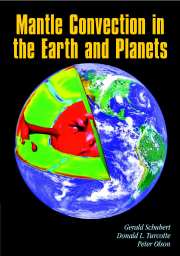Book contents
- Frontmatter
- Contents
- Preface
- 1 Historical Background
- 2 Plate Tectonics
- 3 Structure and Composition of the Mantle
- 4 Mantle Temperatures and Thermodynamic Properties
- 5 Viscosity of the Mantle
- 6 Basic Equations
- 7 Linear Stability
- 8 Approximate Solutions
- 9 Calculations of Convection in Two Dimensions
- 10 Numerical Models of Three-dimensional Convection
- 11 Hot Spots and Mantle Plumes
- 12 Chemical Geodynamics
- 13 Thermal History of the Earth
- 14 Convection in the Interiors of Solid Planets and Moons
- 15 Nature of Convection in the Mantle
- References
- Appendix: Table of Variables
- Author Index
- Subject Index
Preface
Published online by Cambridge University Press: 15 December 2009
- Frontmatter
- Contents
- Preface
- 1 Historical Background
- 2 Plate Tectonics
- 3 Structure and Composition of the Mantle
- 4 Mantle Temperatures and Thermodynamic Properties
- 5 Viscosity of the Mantle
- 6 Basic Equations
- 7 Linear Stability
- 8 Approximate Solutions
- 9 Calculations of Convection in Two Dimensions
- 10 Numerical Models of Three-dimensional Convection
- 11 Hot Spots and Mantle Plumes
- 12 Chemical Geodynamics
- 13 Thermal History of the Earth
- 14 Convection in the Interiors of Solid Planets and Moons
- 15 Nature of Convection in the Mantle
- References
- Appendix: Table of Variables
- Author Index
- Subject Index
Summary
This book gives a comprehensive and connected account of all aspects of mantle convection within the Earth, the terrestrial planets, the Moon, and the Galilean satellites of Jupiter. Convection is the most important process in the mantle, and it sets the pace for the evolution of the Earth as a whole. It controls the distribution of land and water on geologic time scales, and its influences range from the Earth's climate system, cycles of glaciation, and biological evolution to the formation of mineral and hydrocarbon resources. Because mantle convection is the primary mechanism for the transport of heat from the Earth's deep interior to its surface, it is the underlying cause of plate tectonics, formation and drift of continents, volcanism, earthquakes, and mountain building processes. It also shapes the gravitational and magnetic fields of the Earth. Mantle convection plays similar, but not identical, roles in the other planets and satellites.
This book is primarily intended as a research monograph. Our objective is to provide a thorough treatment of the subject appropriate for anyone familiar with the physical sciences who wishes to learn about this fascinating subject. Some parts of the book are quite mathematical, but other parts are qualitative and descriptive. Accordingly, it could be used as a text for advanced coursework in geophysics and planetary physics, or as a supplementary reference for introductory courses.
The subject matter has been selected quite broadly because, as noted above, mantle convection touches on so many aspects of the Earth and planetary sciences. A comprehensive index facilitates access to the content and an extensive reference list does the same for the relevant literature.
- Type
- Chapter
- Information
- Mantle Convection in the Earth and Planets , pp. xiii - xviPublisher: Cambridge University PressPrint publication year: 2001

